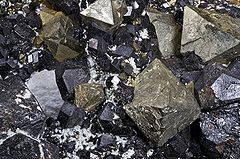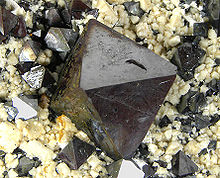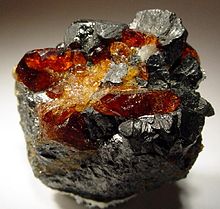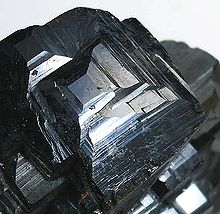- Magnetite
-
Magnetite 
Magnetite and pyrite from Piedmont ItalyGeneral Category Oxide minerals – Spinel group Chemical formula iron(II,III) oxide, Fe3O4 Strunz classification 04.BB.05 Crystal symmetry Isometric 4/m 3 2/m Unit cell a = 8.397 Å; Z=8 Identification Color Black, gray with brownish tint in reflected light Crystal habit Octahedral, fine granular to massive Crystal system Isometric Hexoctahedral Twinning On {Ill} as both twin and composition plane, the spinel law, as contact twins Cleavage Indistinct, parting on {Ill}, very good Fracture Uneven Tenacity Brittle Mohs scale hardness 5.5–6.5 Luster Metallic Streak Black[1] Diaphaneity Opaque Specific gravity 5.17–5.18 Solubility Dissolves slowly in hydrochloric acid References [2][3][4][5] Major varieties Lodestone Magnetic with definite north and south poles Magnetite is a ferrimagnetic mineral with chemical formula Fe3O4, one of several iron oxides and a member of the spinel group. The chemical IUPAC name is iron(II,III) oxide and the common chemical name is ferrous-ferric oxide. The formula for magnetite may also be written as FeO·Fe2O3, which is one part wüstite (FeO) and one part hematite (Fe2O3). This refers to the different oxidation states of the iron in one structure, not a solid solution. The Curie temperature of magnetite is 858 K (585 °C; 1,085 °F). It is black or brownish-black with a metallic luster, has a Mohs hardness of 5–6 and a black streak.
Contents
Properties
Magnetite is the most magnetic of all the naturally occurring minerals on Earth.[6] Naturally magnetized pieces of magnetite, called lodestone, will attract small pieces of iron, and this was how ancient people first noticed the property of magnetism. Lodestones were used as an early form of magnetic compass. Magnetite typically carries the dominant magnetic signature in rocks, and so it has been a critical tool in paleomagnetism, a science important in discovering and understanding plate tectonics and as historic data for magnetohydrodynamics and other scientific fields. The relationships between magnetite and other iron-rich oxide minerals such as ilmenite, hematite, and ulvospinel have been much studied, as the complicated reactions between these minerals and oxygen influence how and when magnetite preserves records of the Earth's magnetic field.
Magnetite has been very important in understanding the conditions under which rocks form. Magnetite reacts with oxygen to produce hematite, and the mineral pair forms a buffer that can control oxygen fugacity. Commonly, igneous rocks contain grains of two solid solutions, one between magnetite and ulvospinel and the other between ilmenite and hematite. Compositions of the mineral pairs are used to calculate how oxidizing was the magma (i.e., the oxygen fugacity of the magma): a range of oxidizing conditions are found in magmas and the oxidation state helps to determine how the magmas might evolve by fractional crystallization.
Small grains of magnetite occur in almost all igneous and metamorphic rocks. Magnetite also occurs in many sedimentary rocks, including banded iron formations. In many igneous rocks, magnetite-rich and ilmenite-rich grains occur that precipitated together from magma. Magnetite also is produced from peridotites and dunites by serpentinization.
Distribution of deposits
Magnetite is sometimes found in large quantities in beach sand. Such black sands (mineral sands or iron sands) are found in various places, such as California and the west coast of New Zealand. The magnetite is carried to the beach via rivers from erosion and is concentrated via wave action and currents.
Huge deposits have been found in banded iron formations. These sedimentary rocks have been used to infer changes in the oxygen content of the atmosphere of the Earth.
Large deposits of magnetite are also found in the Atacama region of Chile, Valentines region of Uruguay, Kiruna, Sweden, the Pilbara, Midwest and Northern Goldfields regions in Western Australia, New South Wales in the Tallawang Region, and in the Adirondack region of New York in the United States. Deposits are also found in Norway, Germany, Italy, Switzerland, South Africa, India, Mexico, and in Oregon, New Jersey, Pennsylvania, North Carolina, Virginia, New Mexico, Utah, and Colorado in the United States. In 2005, an exploration company, Cardero Resources, discovered a vast deposit of magnetite-bearing sand dunes in Peru. The dune field covers 250 square kilometers (100 sq mi), with the highest dune at over 2,000 meters (6,560 ft) above the desert floor. The sand contains 10% magnetite.[7]
Biological occurrences
Crystals of magnetite have been found in some bacteria (e.g., Magnetospirillum magnetotacticum) and in the brains of bees, termites, fish, some birds (e.g., the pigeon) and humans.[8] These crystals are thought to be involved in magnetoreception, the ability to sense the polarity or the inclination of the Earth's magnetic field, and to be involved in navigation. Also, chitons have teeth made of magnetite on their radula, making them unique among animals. This means they have an exceptionally abrasive tongue with which to scrape food from rocks.
The study of biomagnetism began with the discoveries of Caltech paleoecologist Heinz Lowenstam in the 1960s.
Preparation as a ferrofluid
Magnetite can be prepared in the laboratory as a ferrofluid in the Massart method by mixing iron(II) chloride and iron(III) chloride in the presence of sodium hydroxide.[9]
Magnetite also can be prepared by chemical co-precipitation, which consist in a mixture of a solution 0.1 M of FeCl3·6H2O and FeCl2·4H2O with mechanic agitation of about 2000 rpm. The molar ratio of FeCl3:FeCl2 can be 2:1; heating this solution at 70 °C, and immediately the speed is elevated to 7500 rpm and adding quickly a solution of NH4OH (10 volume %), immediately a dark precipitate will be formed, which consists of nanoparticles of magnetite.[citation needed]
Transformation of ferrous hydroxide into magnetite
Under anaerobic conditions, the ferrous hydroxide (Fe(OH)2 ) can be oxidized by the protons of water to form magnetite and molecular hydrogen.[citation needed] This process is described by the Schikorr reaction:
- 3 Fe(OH)2 → Fe3O4 + H2 + 2 H2O
- ferrous hydroxide → magnetite + hydrogen + water
The well-crystallized magnetite (Fe3O4) is thermodynamically more stable than the ferrous hydroxide (Fe(OH)2 ).
This process also occurs during the anaerobic corrosion of iron and steel in oxygen-free groundwater and in reducing soils below the water table.
Application as a sorbent
Magnetite powder efficiently removes arsenic(III) and arsenic(V) from water, the efficiency of which increases ~200 times when the magnetite particle size decreases from 300 to 12 nm.[10] Arsenic-contaminated drinking water is a major problem around the world, which can be solved using magnetite as a sorbent.
Industry
Because of its stability at high temperatures, it is used for coating industrial water tube steam boilers. The magnetite layer is formed after a chemical treatment (e.g. by using hydrazine).
Magnetite is also used as a catalyst for various industrial chemical processes, such as: Fischer-Tropsch process, the Haber-Bosch process and the water gas shift reaction.
Gallery of magnetite mineral specimens
-
Octahedral crystals of magnetite up to 1.8 cm across, on cream colored Feldspar crystals. Locality: Cerro Huañaquino, Potosí Department, Bolivia. Size: 8.4 x 5.2 x 3.2 cm.
-
Unusual octahedral magnetite & chalcopyrite association, Aggeneys, Northern Cape Province, South Africa. Size 7 x 6 x 4 cm.
-
Red gemmy crystals of Chondrodite with magnetite, Tilly Foster mine, Brewster, New York USA. Size 2.8 x 2.6 x 2.1 cm.
-
Unusual specular hematite pseudomorph after magnetite, from Payun Matru volcano, Reserva Provincial La Payunia, Argentina. Size: 11.8 x 5.6 x 4.4 cm.
-
Metallic, jet black, complex cubes of magnetite, from ZCA Mine No. 4, Balmat-Edwards district, St. Lawrence County, New York USA. Field of view, about 4 cm.
See also
- Bluing (steel), a process in which steel is partially protected against rust by a layer of magnetite
- Corrosion product
- Ferrite
- Greigite
- Maghemite
- Magnesia (in natural mixtures with magnetite)
- Magnetotactic bacteria
- Mill scale
- Mineral redox buffer
References
- ^ http://geology.about.com/od/mineral_ident/ig/streak/streakmagnetite.htm
- ^ Handbook of Mineralogy
- ^ Mindat.org Mindat.org
- ^ Webmineral data
- ^ Hurlbut, Cornelius S.; Klein, Cornelis (1985). Manual of Mineralogy (20th ed.). Wiley. ISBN 0471805807.
- ^ Harrison, R. J.; Dunin-Borkowski, RE; Putnis, A (2002). "Direct imaging of nanoscale magnetic interactions in minerals" (free-download pdf). Proceedings of the National Academy of Sciences 99 (26): 16556–16561. doi:10.1073/pnas.262514499. PMC 139182. PMID 12482930. http://www.pnas.org/content/99/26/16556.full.pdf.
- ^ Ferrous Nonsnotus
- ^ Baker, R R; J G Mather, J H Kennaugh (1983-01-06). "Magnetic bones in human sinuses". Nature 301 (5895): 79–80. doi:10.1038/301078a0. PMID 6823284.
- ^ Massart, R. “Preparation of aqueous magnetic liquids in alkaline and acidic media” IEEE transactions on magnetics, 17, 2, 1981. 1247–1248
- ^ J.T. Mayo et al. (2007). "The effect of nanocrystalline magnetite size on arsenic removal" (free download). Sci. Technol. Adv. Mater. 8: 71. doi:10.1016/j.stam.2006.10.005.
Further reading
- Lowenstam, Heinz A.; Weiner, Stephen (1989). On Biomineralization. USA: Oxford University Press. ISBN 0195049772.
- Chang, Shih-Bin Robin; Kirschvink, Joseph Lynn (1989). "Magnetofossils, the Magnetization of Sediments, and the Evolution of Magnetite Biomineralization". Annual Review of Earth and Planetary Sciences 17: 169–195. doi:10.1146/annurev.ea.17.050189.001125. http://www.gps.caltech.edu/~jkirschvink/pdfs/AnnualReviews89.pdf.
External links
- Mineral galleries
- Powder X-Ray Diffraction (XRD) Pattern
- Bio-magnetics
- History of Magnetite Mining in the NJ Highlands
- Magnetite mining in New Zealand Accessed 25-Mar-09
- Magnetite mining in Santa Cruz
- Peruvian sand dunes
Ores Acanthite (silver) · Chalcopyrite (copper) · Chalcocite (copper) · Cinnabar (mercury) · Galena (lead) · Pentlandite (nickel) · Sphalerite (zinc)OtherOre deposit types Banded iron formation · Carbonate hosted lead zinc ore deposits · Heavy mineral sands · Iron oxide copper gold · Kambalda type komatiitic nickel ore deposits · Lateritic nickel · Magmatic nickel-copper-iron-PGE deposits · Porphyry copper · Sedimentary exhalative deposits · Volcanogenic massive sulfideCategories:- Magnetism
- Iron compounds
- Iron minerals
- Spinel group
- Ferromagnetic materials
- Iron oxide pigments
- Cubic minerals
Wikimedia Foundation. 2010.








